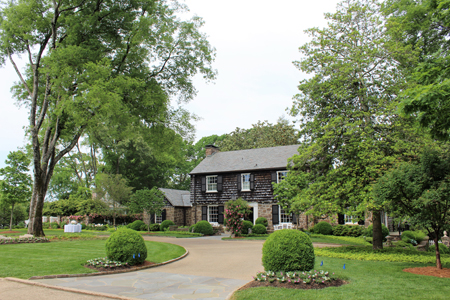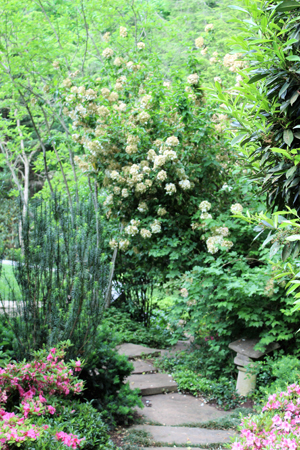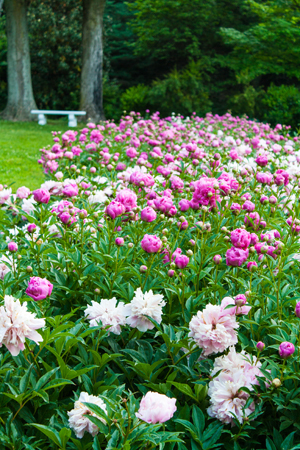Story by Gay Lyons
Photography by Elizabeth Campbell, Britt Cole and Melinda Ethier
Whether you’re a gardener yourself or just enjoy looking at the beautiful spaces created by these talented people, there’s something restorative about a garden.
Come with us behind the garden gates for a glimpse of some of Knoxville’s prettiest private gardens.
New Life for an Old Garden
Four years ago when Melinda and Jim Ethier renovated the house they’ve lived in for 30 years, Stephen W. Hackney Landscape Architecture worked with Melinda to design a new plan for the yard and garden.
“Now my “old” garden is a “young” garden,” said Melinda, “settling in and establishing happy places for favorite plants.”
“I had some special ‘old bones’ to work with and around,” she continued. “The front
yard was dominated by two old magnificent trees, an American Holly and a Hackberry. We managed to move and save all the existing boxwoods as well as a stunning specimen Burgundy Lace Maple that has to be 50 years old and is now one of the focal points
in the poolside garden.”

Spring begins with Daffodils, Tulips, Virginia Bluebells, Celandine Poppies, Bleeding Hearts and Blue Star Creepers. Ferns, Lady’s Mantle, Japanese Anemone and other delicate plants begin emerging in the Elephant Shade Garden. The riot of color starts with the Bearded Iris, Peggy Martin Roses, Allium Globemaster, Walker’s Low Nepeta and Nelly Moser Clematis climbing the gate trellis along with Sarah Bernhardt Peonies, Lily of the Valley and the antique rose climbing over the conservatory.
“I didn’t have a big sunny area before the renovation so I am having fun experimenting with Hybrid Tea Roses and Dahlias in the new sun/cutting garden,” said Melinda. “Two white wooden tudors anchor this garden with Princess Diana Clematis weaving their way up to the sun.”
Gardening Therapy
Carlton and Arthur Long renovated their garden in 2005, which involved “a lot of earth moving.” “We had a sloping backyard, so we brought in a lot of dirt,” said Carlton. “I tore pictures out of magazines and said ‘I’d like this section to look like this.’

"The garden came together through Arthur’s creativity and knowledge of engineering and photos of other gardens," Carlton continued. "It was designed based on things we love, plants I loved growing up. A fun part of gardening for me is seeing how things change.”
A recent change has taken some “getting used to.” The Longs lost 200 boxwoods to blight in the last two years and replaced them with Hoogendorn Holly.
“We do all the work ourselves,” said Carlton. “We don’t have a gardener or a lawn service. I get great peace and satisfaction being in the garden. I enjoy the break in fall and winter and then when spring comes, I’m ready to get back out there.”
“We’re in a neighborhood, but I feel like we have a lot of privacy,” she continued. “It feels very secluded. Sitting at our outdoor fireplace feels like being in the mountains. We have a brook because we needed a drainage ditch.”
“Gardening has given me so much pleasure and has been my therapy for years,” said Carlton. “I tell Arthur that he has saved plenty of money by never having to pay a therapist. My mind is healthier, I get a great workout and I see instant gratification by the progress I have made that day.”
Middlebrook's Antebellum Peonies
“The peonies at Middlebrook do best if left alone,” said Rick Fox, the home’s current owner. “All we do is deadhead them after they bloom and cut them down after the first frost.”
These are hardy flowers. They have been blooming every spring since before the Civil War. The first house on the property was a log house built in 1795. By 1835, Middlebrook was a slave run plantation. After the battle of Fort Sanders in 1863, the Confederate troops retreated to Middlebrook and used the house as a hospital. As many as 250 soldiers died there and were buried on the property.

The music room temporarily became a room for surgery because of the four large windows for ventilation. The wood floor in that room has been carpeted ever since because of the blood stains from that time.
During the Civil War, the house was surrounded by Union troops who camped in the gardens and whose horses ate the flowers. After the war the gardens were moved to the side of the house where the original red, pink and white peonies brought from Asia in the 1830’s still bloom each spring.